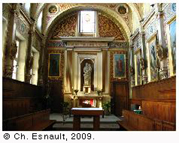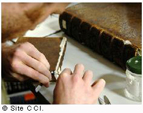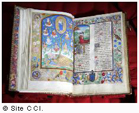Archaeologists, tools at the ready - discover Ireland in Paris
- Last Updated: Saturday, 07 October 2023 21:12
- Published: Tuesday, 14 February 2017 10:16
- Written by Jean-Olivier Gransard-Desmond Translated by Fahy J. and Schmitt M.
- Hits: 4327
In keeping with our Irish theme for 2009, the Irish Cultural Center (Centre Culturel Irlandais or CCI) was a must-visit to discover the history of the Irish and their community in France and in Paris, where what became the Irish College lives on today. So on Wednesday, March 11, Arkeotopia gathered its members and some curious guests and set out on an ArkaeOdyssey discovery tour of the Center followed by a discussion at the Saint-Hilaire pub.
 The outing also provided an opportunity, thanks to the Irish Cultural Center's heritage collection, to introduce the topic of how illuminated manuscripts were made. This would be examined in more detail at the ArkaeoBreak on April 24, and the ArkaeoMovies screening on May 16, culminating with the presentation of the Book of Kells at Trinity College in Dublin.
The outing also provided an opportunity, thanks to the Irish Cultural Center's heritage collection, to introduce the topic of how illuminated manuscripts were made. This would be examined in more detail at the ArkaeoBreak on April 24, and the ArkaeoMovies screening on May 16, culminating with the presentation of the Book of Kells at Trinity College in Dublin.
Transporting the visitors to another time, as one of the participants later put it, the small group met in the Center’s courtyard. From there, guided by Carole Jacquet, the Center’s Head of Libraries and Archives, the tour began in St. Patrick's Chapel.
The media library and heritage library were next, and the tour ended with the exhibition space. While there were many questions, Dr. Gransard-Desmond’s input frequently built on Ms. Jacquet’s remarks, putting her words into perspective for the group in terms of archaeology, relating to the work involved in restoring and preserving books, as well as the building and its collection.
The conversation even illustrated just how much an archaeological study of the building and its contents is lacking when compared to the existing historical studies and the important preservation work that has been carried out. Here, it seems appropriate to digress a little, to draw the attention of professional and amateur researchers as well as students who might be interested in the subject. The preservation and restoration program is a priority for the Irish Cultural Center and it will take more than a few years to carry out. So naturally, the Center is focused on top-notch work in order to grant researchers access to the data that will allow them to work in the best possible conditions.
The fact that archaeologists have yet to study this well-known and often-visited site is both a surprise and a pity. Situated in the heart of Saint-Geneviève’s hill, which harbors many additional treasures such as the Pantheon, Saint-Geneviève’s library, and Sainte-Hilaire’s Cathedral, the Irish College hasn’t benefited from as many studies as these monuments. Not only are archaeological studies lacking, but historical uncertainties remain to this day. For example, the date the Irish College opened is given as 1775 by some (Caillet, 1991, p. 152) and 1776 by others (McDonnell, 2002, p. 166). The date of the consecration of the chapel has never been recorded. As another example, the date on the ownership title of the property that would go on to house the Irish College buildings is known to be May 7, 1772 (Caillet, 1991, p. 152). So what is the significance of May 22, 1772, the date found on the ownership title signed by Lawrence Kelly (CCI archive A2.a1)?
For example, the date the Irish College opened is given as 1775 by some (Caillet, 1991, p. 152) and 1776 by others (McDonnell, 2002, p. 166). The date of the consecration of the chapel has never been recorded. As another example, the date on the ownership title of the property that would go on to house the Irish College buildings is known to be May 7, 1772 (Caillet, 1991, p. 152). So what is the significance of May 22, 1772, the date found on the ownership title signed by Lawrence Kelly (CCI archive A2.a1)?
Another question raised by this document is the mention of a property being situated on the rue des Irlandais, although this street name did not replace the previous name rue du Cheval Vert until after 1869 (note that the mention appears to have been added after the deed was drawn up). These uncertainties will surely be resolved quickly given the interest in the archives and the history of the community. But what about the fact that archaeological studies of the site are either non-existant or so confidential that the Irish Cultural Center couldn’t even source one in preparation for this ArkaeOdyssey?
A study would be interesting if it could provide, for example, some clarity on the tiling in the heritage library. The flooring was described in 2002 as being original (McDonnell, 2002, p. 166, citing Caillet, 1995), but according to Ms. Jacquet, it was remodeled during the 2002 renovations. Far from placing the author at fault, this example demonstrates just how wise it would be to quickly undertake an archaeological analysis of the building. Additionally, with the Irish Cultural Center digitizing its archives to facilitate access to researchers and promoting all work concerning France-Ireland relations, research in the form of a master’s degree, a doctorate, or a thorough study carried out by an archaeologist interested in the eighteenth to twenty-first centuries would be more than welcome here. That’s certainly how Ms. Jacquet reacted to the offer to spread the word to universities and researchers who might be interested.
Additionally, with the Irish Cultural Center digitizing its archives to facilitate access to researchers and promoting all work concerning France-Ireland relations, research in the form of a master’s degree, a doctorate, or a thorough study carried out by an archaeologist interested in the eighteenth to twenty-first centuries would be more than welcome here. That’s certainly how Ms. Jacquet reacted to the offer to spread the word to universities and researchers who might be interested.
 After getting the chance to admire the illuminated codices from the fifteenth to sixteenth centuries that were presented for the occasion (a history of the kings of England, a Flemish psalter, and a book of hours from Notre-Dame), a document from the collection carrying an ex libris etching and an ownership marking was discussed. Then the group was invited to adjourn to the pub.
After getting the chance to admire the illuminated codices from the fifteenth to sixteenth centuries that were presented for the occasion (a history of the kings of England, a Flemish psalter, and a book of hours from Notre-Dame), a document from the collection carrying an ex libris etching and an ownership marking was discussed. Then the group was invited to adjourn to the pub.
Participants took a brief detour to the former Irish chapel of the Lombards College (Collège des Lombards) on the rue des Carmes (known as the church of Saint-Ephrem-des-Syriens since 1925) before continuing their discussion with Dr. Gransard-Desmond over a beer. The group returned to the meaning of the term “college” in order to make the distinction between the community and the building; they discussed the history of the Irish College building and the unanswered archaeological questions that remain today; they touched on the difference between the approach of a historian and that of an archaeologist; they examined the difference between an incunable and a manuscript and began to expand on the work of book archaeology, to appreciate the role that ownership markings played in tracing the collections of the different colleges and seminaries gathered under the Irish College; and they recounted the origin stories of the street names mentioned that evening. The rue du Cheval vert (literally, Green Horse Road), for example, got its name from a fifteenth-century tale of revenge: a dyer retaliated against the coachman who had stolen money from him by painting his horse green. Regardless of the music and traditional pub noises that surrounded them, the delighted participants finally ate together and parted ways around 11 p.m., already making plans for the next activity.
Some reference sites
- Centre Culturel Irlandais (CCI) 5 rue des Irlandais 75005 Paris / 01.58.52.10.30 - www.centreculturelirlandais.com. Here you will find an account of the history of the Irish College as well as the Historical Archives catalog and the Multimedia Library catalog (access to the Multimedia Library is free and open to everyone). If you would like to attend any of the services or events at Saint Patrick's Chapel, we remind you that they are held in English.
- History Ireland is a magazine featuring articles and reviews of books on Irish history - www.historyireland.com/
- Irish Archaeology - Sharing Ireland’s amazing archaeology as well as interesting sites from around the world. A blog by Wexford archaeologists Colm Moriarty and Adrienne Corless - irisharchaeology.ie/li>
- The Irish Association of Paris (L'Association irlandaise de Paris) welcomes lovers of Ireland in the 14th arrondissement - 22 rue Delambre 75014 Paris / 01.47.64.39.31 - www.association-irlandaise.org
- Le comptoir irlandais is the meeting place of those who are curious about and those who love Ireland, who want to shop without having to take a plane - www.comptoir-irlandais.com
- Embassy of Ireland in France - 12 avenue Foch 75116 Paris (entrance 4 rue Rude) / 01 44 17 67 00 - https://www.dfa.ie/irish-embassy/france/
Bibliographie
- Caillet M. (1991): « La bibliothèque du Collège des Irlandais et son fonds de livres anciens », Mélanges de la Bibliothèque de la Sorbonne 11, Paris, pp. 151-163.
- Caillet M. (1995): « Bibliothèque du Collège des Irlandais », in: Robichon Fr. (éd.), Patrimoine des bibliothèques de France : un guide des régions - Vol. 1, Île-de-France, Paris, pp. 168-169.
- McDonnell J. (2002): "From Bernini to celtic revival : a tale of two Irish College in Paris", Irish Arts Review 18, pp. 165-175.






